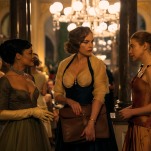Required Reading: Comics for 5/31/2017
Main Art by Charles Forsman
We hope you’re enjoying (or, depending on when you’re reading this, enjoyed) your Memorial Day on a beach, in a park or otherwise far away from an office—and bonus points if comic books play a part in your day-off strategy. This Wednesday offers a spectrum of choices from the Wonder Woman Annual, timed perfectly for Amazonians who just can’t wait for the Gal Gadot film hitting theaters this weekend, to Boundless, Jillian Tamaki’s latest collection of indie-cool comic shorts. Marvel hits peak ‘90s with a Cable relaunch that emphasizes the future fighter’s big-ass guns, and frequent Marvel contributor Dustin Weaver strikes out on his own with Paklis, a solo anthology for Image that promises to show off the full breadth of his interests and massive talent. And if you’re looking to tune in and drop out, the first gyro-laden collection of Gerard Way, Nick Derington and Tamra Bonvillain’s mind-expanding Doom Patrol hits stands for your trip-out pleasure.
 Aliens: Dead Orbit #2
Aliens: Dead Orbit #2
Writer/Artist: James Stokoe
Publisher: Dark Horse Comics
Anyone disappointed by Alien: Covenant’s philosophical posturing and lukewarm action, fret not: the claustrophobic dread of Ridley Scott’s 1979 game-changing film beats deeply in the panels of Dead Orbit. Writer/artist James Stokoe adorns his pages with a dizzying amount of detail; space debris orbits hulking ships covered in entropy, like ancient monuments viewed through an ‘80s manga sci-fi filter. The hugeness of the dead, uncaring universe contrasts with the intimate journey of protagonist Wascylewski, an engineer stranded onboard the Atol Sphacteria. Stokoe flips between past and present to show how “Wassy” became marooned alongside the iconic H. R. Giger-designed genitalia monster, and it is scary as hell. The cover for this sophomore issue hints at what calamity may have ensued. Dead Orbit has the rare ability to present an engulfing aura of doom in a few pages, with characterization built around regret and good intentions that unintentionally invites chaos. No artist can explore the textures between metal and flesh as capably as Stokoe, enbodying the uncomfortable themes of horrific reproductivity that lie at the heart of this franchise. Sean Edgar
-

-

-

-

-

-

-

-

-

-

-

-

-

-

-

-

-

-

-

-

-

-

-

-

-

-

-

-

-

-

-

-

-

-

-

-

-

-

-

-

















































